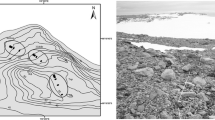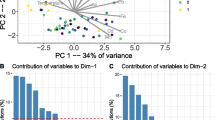Abstract
Geothermal influenced soils exert unique physical and chemical limitations on resident microbial communities but have received little attention in microbial ecology research. These environments offer a model system in which to investigate microbial community heterogeneity and a range of soil ecological concepts. We conducted a 16S bar-coded pyrosequencing survey of the prokaryotic communities in a diatomaceous geothermal soil system and compared communities across soil types and along a conspicuous photic depth gradient. We found significant differences between the communities of the two different soils and also predictable differences between samples taken at different depths. Additionally, we targeted three ecologically relevant bacterial phyla, Cyanobacteria, Planctomycetes, and Verrucomicrobia, for clade-wise comparisons with these variables and found strong differences in their abundances, consistent with the autecology of these groups.





Similar content being viewed by others
References
Belnap J, Lange O (2003) Biological soil crusts: structure, function, and management. Springer, New York
Bergmann GT, Bates ST, Eilers KG, Lauber CL, Caporaso JG, Walters WA, Knight R, Fierer N (2011) The under-recongnized dominance of Verrucomicrobia in soil bacterial communities. Soil Biol Biochem 43:1450–1455
Bowker M, Maestre F, Escolar C (2009) Biological crusts as model system for examining the biodiversity-ecosystem function relationship in soils. Soil Biol Biochem 42:405–417
Bunn RA, Zabinski CA (2003) Arbuscular mycorrhizae in thermal-influenced soils in Yellowstone National Park. West N Am Nat 63:409–415
Caporaso JG, Bittinger K, Bushman FD, DeSantis TZ, Andersen GL, Knight R (2010) PyNAST: a flexible tool for aligning sequences to a template alignment. Bioinformatics 26:266–267
Caporaso JG, Kuczynski J, Stombaugh J, Bittinger K, Bushman FD, Costello EK, Fierer N, Pena AG, Goodrich JK, Gordon JI, Huttley GA, Kelley ST, Knights D, Koenig JE, Ley RE, Lozupone CA, McDonald D, Muegge BD, Pirrung M, Reeder J, Sevinsky JR, Tumbaugh PJ, Walters WA, Widmann J, Yatsunenko T, Zaneveld J, Knight R (2010) QIIME allows analysis of high-throughput community sequencing data. Nat Methods 7:335–336
R Development Core Team (2010) R: a language and environment for statistical computing. R Foundation for Statistical Computing, Vienna, Austria. http://CRAN.R-project.org
Ehrenfeld JG, Ravit B, Elgersma K (2005) Feedback in the plant-soil system. Annu Rev Environ Resour 30:75–115
Fierer N, Jackson RB (2006) The diversity and biogeography of soil bacterial communities. PNAS 103:626–631
Fierer N, Lennon J (2011) The generation and maintenance of diversity in microbial communities. Am J Bot 98:439–448
Hendershot WH, Lalande H, Duquette M (2008) Soil reaction and acidity. In: Carter MR, Gregorich EG (eds) Soil sampling and methods of analysis, vol 2. CRC Press, Boca Raton
Herlemann DPR, Labrenz M, Jürgens K, Bertilsson S, Waniek JJ, Andersson AF (2011) Transitions in bacterial communities along the 2000 km salinity gradient of the Baltic Sea. ISME 5:1571–1579
Horner-Devine MC, Bohannan BJM (2006) Phylogenetic clustering and overdispersion in bacterial communities. Ecology 87:100–108
Housman DC, Powers HH, Collins AD, Belnap J (2006) Carbon and nitrogen fixation differ between successional stages of biological soil crusts in the Colorado Plateau and Chihuahuan Desert. J Arid Environ 66:620–634
Kembel SW, Cowan PD, Helmus MR, Cornwell WK, Morlon H, Ackerly DD, Blomberg SP, Webb CO (2010) Picante: R tools for integrating phylogenies and ecology. Bioinformatics 26:1463–1464
Kuczynski J, Liu ZZ, Lozupone C, McDonald D, Fierer N, Knight R (2010) Microbial community resemblance methods differ in their ability to detect biologically relevant patterns. Nat Methods 7:813–821
Lauber CL, Hamady M, Knight R, Fierer N (2009) Soil pH as a predictor of soil bacterial community structure at the continental scale: a pyrosequencing-based assessment. Appl Environ Microbiol 75:5111–5120
Liu Z, Lozupone CA, Hamady M, Bushman FD, Knight R (2007) Short pyrosequencing reads suffice for accurate microbial community analysis. Nucleic Acids Res 35:e120
Lozupone CA, Hamady M, Knight R (2006) UniFrac—an online tool for comparing microbial community diversity in a phylogenetic context. BMC Bioinforma 7:371
Madigan MT, Martinko JM, Dunlap PV, Clark DV (2008) Brock biology of microorganisms, 12th edn. Pearson Higher Education, New York
Meadow JF, Zabinski CA (2012) Spatial heterogeneity of eukaryotic microbial communities in an unstudied geothermal diatomaceous biological soil crust: Yellowstone National Park, WY, USA. FEMS Microbiol Ecol. doi:10.1111/j.1574-6941.2012.01416.x
Oksanen J, Blanchet FG, Kindt R, Legendre P, O’Hara RB, Simpson GL, Solymos P, Stevens MHH, Wagner H (2011) Vegan: community ecology package. http://CRAN.R-project.org/package=vegan, R package version 1.17-6
Philippot L, Andersson SVE, Battin TJ, Prosser JI, Schimel JP, Whitman WB, Hallin S (2011) The ecological coherence of high bacterial taxonomic ranks. Nat Rev Microbiol 8:523–529
Price MN, Dehal PS, Arkin AP (2009) FastTree: computing large minimum-evolution trees with profiles instead of a distance matrix. Mol Biol Evol 26:1641–1650
Roberts DW (1986) Ordination on the basis of fuzzy set theory. Vegetatio 66:123–131
Roberts DW (2008) Statistical analysis of multidimensional fuzzy set ordinations. Ecology 89
Roberts DW (2010a) fso: fuzzy set ordination. http://CRAN.R-project.org/package=fso, R package version 1.2-0
Roberts DW (2010b) labdsv: ordination and multivariate analysis for ecology. http://CRAN.R-project.org/package=labdsv, R package version 1.4-1
Rowe JJ, Fournier RO, Morey GW (1973) Chemical analysis of thermal waters in Yellowstone National Park, Wyoming, 1960–65. Geological Survey Bulletin 1303, Department of the Interior
Tamura K, Peterson D, Peterson N, Stencher G, Nei M, Kumar S (2011) MEGA5: molecular evolutionary genetics analysis using likelihood, distance, and parsomony methods. Mol Biol Evol 28:38–44
Tringe SG, von Mering C, Kobayashi A, Salamov AA, Chen K, Chang HW, Podar M, Short JM, Mathur EJ, Detter JC, Bork P, Hugenholtz P, Rubin EM (2005) Comparative metagenomics of microbial communities. Science 308:554–557
Wagner M, Horn M (2006) The Planctomycetes, Verrucomicrobia, Chlamydiae and sister phyla comprise a superphylum with biotechnological and medical relavance. Curr Opin Biotechnol 17:241–249
Wardle DA (2002) Communities and ecosystems: linking the aboveground and belowground components. Number 34 in Monographs in population biology. Princeton University Press
Wickham H (2009) ggplot2: elegant graphics for data analysis. Springer, New York
Yeomans JC, Bremner JM (1991) Carbon and nitrogen analysis of soils by automated combustion techniques. Commun Soil Sci Plant Anal 22:843–850
Zak DR, Holmes WE, White DC, Peacock AD, Tilman D (2003) Plant diversity, soil microbial communities, and ecosystem function: are there any links? Ecology 84:2042–2050
Acknowledgments
We are grateful to the Yellowstone National Park permit personnel for help with permitting; to the Grand Teton Association for financial support through the Boyd Evison Graduate Fellowship to JM; to the Institute on Ecosystems for financial support through a Dissertation Fellowship to JM; to D. Skorupa, S. Clingenpeel, and T. R. McDermott for their help with primer design, barcoding, and amplification; and to R. Castenholz for assistance with irradiance measurement.
Author information
Authors and Affiliations
Corresponding author
Electronic supplementary material
Below is the link to the electronic supplementary material.
Supplemental Figure 1
Comparison of phylogenetic unweighted UniFrac distances to qualitative Ochiai (a) and quantitative Canberra (b). Correlation coefficients (r values) indicate that limited additional information was gained by considering phylogenetic relationships (JPEG 45 kb)
ESM 1
(TXT 2 kb)
ESM 2
(TXT 2 kb)
Rights and permissions
About this article
Cite this article
Meadow, J.F., Zabinski, C.A. Prokaryotic Communities Differ Along a Geothermal Soil Photic Gradient. Microb Ecol 65, 171–179 (2013). https://doi.org/10.1007/s00248-012-0103-1
Received:
Accepted:
Published:
Issue Date:
DOI: https://doi.org/10.1007/s00248-012-0103-1




